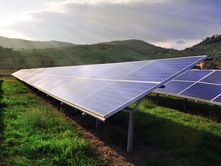top of page
All Articles


Zambia Powers Up: Renewable Energy Revolution Takes Center Stage
Zambia is part of the Africa Minigrids Program (AMP), a UNDP initiative focused on driving private-sector assessment of solar minigrids. They are doing this by implementing cost-reduction strategies and promoting innovative business models. The AMP is funded by the Global Environment Facility (GEF) and implemented in partnership with RMI and the African Development Bank.


Siwa Oasis: A Solar-Powered Transformation Facing Environmental Threats
Solar energy holds immense potential to transform life in the oasis by effectively harnessing its abundant natural resources. However, this potential can only be realized if stringent regulations are established to prevent misuse, ensuring that the intended benefits are not undermined or reversed.


Africa's Green Energy Gets EU Boost
Access to clean, renewable energy remains one of Africa’s biggest challenges, amid reports that up to 600 million people still lack access to reliable electricity. Yet, Africa has significant potential for renewable energy that can help the continent transition from unclean energy sources like biomass to renewable energy. This transition could shape Africa’s future development, regional stability, and progress amid climate change.


In Zimbabwe, Mini-Power Stations are Driving Change
Mini-grids have the potential to transform Zimbabwe's rural communities, providing clean, reliable energy and driving economic growth. With continued investment and support, these initiatives can help bridge the energy access gap and improve the lives of millions of Zimbabweans.


Solar-Powered Irrigation: An Agricultural Revolution Taking Root in Egypt
According to studies, solar-powered irrigation systems are expected to become more feasible and efficient with technological advancements, helping expand the transition from diesel to clean solar energy. This transformation could redefine the future of Egyptian agriculture.


In Africa, Solar Energy is Booming
The rise in solar panel imports is a continent-wide phenomenon, with 20 countries setting new records in the 12 months to June 2025. Twenty-five countries imported at least 100 MW, up from 15 countries the previous year. If installed, the solar panels imported into Sierra Leone over the last 12 months would generate electricity equivalent to 61 percent of the country's total reported electricity generation in 2023.


India's Solar Surge
India is building up its domestic solar photovoltaic (PV) manufacturing. With supportive policies, rising domestic demand, and a global push to diversify renewable energy supply chains away from dependence on China, India is working towards solar manufacturing autonomy.


Pumping Life with Solar Power into Zimbabwe's Small-Scale Farms
However, buoyed by low-cost solar-powered water pumps—also known as photovoltaic water pumping systems—some innovative small-scale farmers in Zimbabwe are now able to irrigate their crops and eliminate the need for rain-fed agriculture. According to experts, the use of solar energy to power groundwater pumps by farmers in drought-ridden, off-grid regions in Africa and elsewhere has been heralded as potentially revolutionary.


Will New Financing Models Boost Africa's Renewable Energy?
With innovative financing for clean energy like the Ilute solar project, the future looks bright for the expansion of solar energy in Zambia. However, it remains to be seen whether such a financing structure will be replicated in other African countries. Only time will tell.


A Case for Floating Solar Plants
A recent study reveals that "floating solar photovoltaic systems are rapidly gaining traction due to their potential for higher energy yield and efficiency compared to conventional land-based solar photovoltaic systems.” The technology, studies have indicated, generates 0.6 percent to 4.4 percent more energy and exhibits efficiency improvements ranging from 0.1 percent to 4.45 percent over land-based solar power plants.


The Movement toward Microgrids
The combination of new technologies and new methods of financing has set the stage for microgrids to play a major role in decarbonization. The method of providing energy as a service, and therefore moving the upfront cost away from consumers, has shown significant popularity. The falling costs of both battery storage and solar technology have made microgrids a more attractive option, while reports from the DoE emphasize the role they can play in grid stability and resiliency.


Turning the Tide Against Plastic Pollution with Renewable Solutions
As Southeast Asia tackles plastic pollution and its environmental challenges, integrating renewable energy into waste management offers a promising solution, helping to reduce plastic waste and lower the carbon footprint. With policy support, grassroots innovation, and sustainable practices, the region is taking meaningful strides toward a cleaner future.
bottom of page



